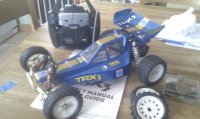TOPIC:
BEC confusion 11 years 3 months ago #17916
|
OK, I get old receivers need a nominal 6v supply to work correctly as provided by 4 x AA batteries.
Now, modern BEC receivers - What voltage range do they accept? I am presuming that the have a built-in voltage regulator that drops the input down to the right level - Am I right? In this case, to use a BEC rx on an old car with a MSC, can I just connect a wire direct to the battery voltage to supply the rx (maybe with a resistor to limit current)? I gets really confusing with "BEC" ESCs. What voltage do they provide to the receiver? Do they have a voltage regulator built-in too? If so, do you need to have a BEC receiver with a BEC ESC? Or does a "BEC" ESC just mean it has a wire to the receiver with battery voltage on it? I'm confused... |
|
Please Log in to join the conversation. |
BEC confusion 11 years 3 months ago #17917
|
IMHO the BEC stands for to use the recevier also on the main battery using the BEC ESC. There has to be some kind of transformator. Maybe the manual will tell you more. Would be interesting for me also. I had some problems with a new Tamiya 104 ESC on my very old Futaba BEC Receiver. It was working but non stop bleeping.
Edit: BEC = Battery Eliminator Circuit. Regulates 7v-24v to 5v for the radio receiver! ....arrrww - now i've read first time the manual of my R/C. There are some informations about noise when 2 cables touching (from motor to ESC and from ESC to receiver) or there is no ceramic capacitors on bigger motors. Need shielded cables! |
|
Please Log in to join the conversation.
Last edit: by funkindemup.
|
BEC confusion 11 years 3 months ago #17921
|
I don't think there's a generally agreed standard of what BEC actually is that everyone is working to, so this is just my understanding (without any research/cross checking TBH
Earliest RC cars (say 1976 to 1985?): 6v (or later, 7.2v) 5 (or 6) cell Nicad main batteries just powering the motor via an MSC (mechanical speed control). Receiver (RX) powered by four AA size batteries, providing 6v (or 4.8v, later, in the case of rechargeable cells). c.1985/6? - first appearance of BEC "Battery Eliminator Circuity", in the form of a small PCB (with its components hidden under a potting compound) on top of the RX power switch. I think the Fox was the first car to use this? Or Maybe the Hotshot. Power came from a cable terminating in a 2-pin JST connector soldered on to the MSC - so providing 7.2v (or more) to the BEC/switch, which dropped it to 4.8v (or 6v? lower than 7.2v+ anyway) for the RX 1986/7? - "BEC" starts appearing on recievers, i.e. the RX had the circuitry onboard to drop the input from the MSC cable (6v to 8.4v by then) to the 4.8 or 6 it & the servos could handle. The earlier BEC equipped switch was no longer necessary, and reverted to a regular switch. Period ESCs (electronic speed control) - no idea, I never had one 2008 (and before that, but that's when I came back into the hobby): 2 distinct types of ESC: The Tamiya ESC - power supply for the RX via a 2-pin JST connector. Functionally, this is equivalent to an MSC with the same 2-pin JST connector in that it's totally unregulated - it gives out whatever voltage the main drive battery produces - 6v, 7.2v, 8.4v +, whatever. You need one of the early swich mounted BECs, a later "UBEC" (universal BEC), or an RX with a BEC circuit on it. Every other sort of ESC - no 2-pin JST connector, just the 3-pin servo type lead which plugs into the RX. Power (almost always "BEC" regulated to 4.8V / 1A) is carried via the +ve wire on that lead, no separate power cable required. No other BEC devices/circuits required, including the RX, even though most RXs up to 2010 will have the circuit on board. 2010 or so - new RXs start losing the BEC circuit, e.g. Planet R6M (?) (the one that came with the T5 TX), Acoms 2.4ghz, cheap imported 27mhz units, etc. This isn't a problem unless you have a Tamiya ESC, in which you need a UBEC. I think the specs for the Planet RX are something like minimum 4.5v, with the magic smoke escaping at 6.1v Fundamentally, unless you want to use the 4x AA cell holder, you'll need at least one device on the car with BEC on/in it - whether it's an "old" switch mounted BEC, a BEC standard ESC, a BEC capable RX, or a UBEC device. More that one BEC won't hurt, i.e. a "BEC" ESC and a BEC RX will be fine. Theoretically you could use any number of BEC equipped/capable devices, but any more than one would be redundant. |
|
Please Log in to join the conversation. |
BEC confusion 11 years 3 months ago #17935
|
Receivers contain electronics, & chips in particular mainly like 5v, so radio gear & ESC electronics work on 5v.
we're talking about how you get your 5v for the electronics from your main (6v, 7.2v etc) battery, which (In the case of a 7.2v NiCd) will be as much as 11.8v straight off the charger. MOST BEC circuits use either a dedicated voltage regulating circuit, or a variation on the LM7805 voltage regulator chip. If you have the Rx or ESC to bits & look for the regulator chip (Usually one of the first components connected at the main battery input), have a look at the numbers on top of it - if it's a 3-pin device stamped LM7805, 7805, UA7805 etc, it's a 5v regulator chip. Most of these are rated 18v max, but the more voltage dropping (Or current passing) it's doing, the hotter it will run. Before you have any voltage related problems/destruction with your Rx/ESC, check the voltages with a multimeter before plugging the stuff in. If you can't find 5v to power the radio, use a LM7805 regulator chip, in-line with the main battery. The full-size device will supply a stable 5vdc at up to 1 amp. Or of course, you could always find a separate 4.8-6v battery pack to do the job instead. As for jittery servos, I've known cheapy chinese or High torque ones to do that if the battery voltage is a bit low. I've also known it to be caused by the ESC failsafe kicking in, for the same reason. Not had any problems with Tamiya ESCs (Yet). 1st job, check your battery voltage - Nimh packs are useless in my opinion, so look there first.
Custom F2
...
Hilux crossmember drawing
...
F2 axle drawing
...
Quattro radio lid
...
Holiday Buggy motor bracket drawing
...
Quattro resto
...
HitnMiss engine
...
Wild Willy resto
...
Mardave Cobra resto
...
Thunder Dragon resto
...
Grasshopper resto
...
XR311 resto
...
Modded XR311
...
Carbon 25th scratch build
|
|
|
Please Log in to join the conversation. |
BEC confusion 11 years 3 months ago #17955
|
OK, that's a little clearer.
In short, if a Rx is marked BEC, you can stick in pretty much any voltage (within reason). If the ESC is marked BEC, the voltage output may or may not be regulated to 5V. In the case of modern ESCs where the power is supplied via the servo cable, is it possible to use these with older Rx's (e.g. Acoms ARB-227), maybe with some modifications? |
|
Please Log in to join the conversation. |
BEC confusion 11 years 3 months ago #17958
|
If an ESC is marked (or it's in the specs) as being BEC, it definitely will be delivering something in the 4.8v range TBH it would be pretty gormless for an ESC manufacturer to produce an ESC with a 3pin servo type power connection without BEC, but I wouldn't like to guarantee no-one has Older RXs, I don't know, I've never tried it. Leaving aside the issue of different servo lead plugs/sockets, having power for the RX & steering servo supplied on the servo type lead relies on everything being interconnected in a certain way within the RX ... I suspect eddrick would know |
|
Please Log in to join the conversation. |
BEC confusion 11 years 3 months ago #17971
|
I can tell you from experience, that older (Non BEC) RXs, servos etc will run on a straight 7.2vdc supply, BUT a charged 7.2v NiCd pack will be poking out a lot more than that & fry them (Normally the RX goes bang before servos). The way around that is to use an LM7805 regulator chip (Less than a quid, 1 amp capable, only 3 pins to connect, no other components needed), OR use a vintage Tamiya "regulator" type RX switch (They have a small PCB/components attached to them), OR use a separate 4xAA pack to power the radio, OR use an ESC that definately has 5vdc coming out of the "servo lead" from it (On the fine red wire).
With the ESC option, check the voltage output with a multimeter before connecting it to your RX, it should be smack on 5v regardless of the main battery voltage. - I've always assumed this connection would be 5v, because the internal electronics run at 5v, so it would be dumb to not bring it out of the ESC to power the RX, but I've heard stories that some modern ones don't (I guess, on the assumption that all modern RXs have BEC, which they don't...). As I said, to avoid tears, check the voltages with a multimeter before plugging stuff in, just to make sure. Finally, however you decide to power the RX (By separate battery, LM7805, ESC etc) make sure ALL the -ve (Black, usually) wires are connected, to maintain a common 0v for the interconnected bits (& yes all the -ve pins are connected together, as are all the +ve pins, internally in an RX, so you can feed your power supply in on any of the "Channel" or "Batt" connections). The 0v connection is usually used as a "reference" for the RX to position servos (& ESC). We all assume that red=5v, black=0v, but that's not necessarily true - the potential difference between red & black will be 5v, but it could be that red is 3v & black is -2v, red is 12v & black is 7v etc. ie the actual values don't matter, it's the difference between them them that shows on your multimeter & is what's important for the equipment. If you connect all your blacks together, the voltage on that wire will be the same value for all of the equipment. The only way to make "0v" truly 0v, is to "Ground" it, ie stick the end of the wire in the mud, which doesn't work well for toy cars
Custom F2
...
Hilux crossmember drawing
...
F2 axle drawing
...
Quattro radio lid
...
Holiday Buggy motor bracket drawing
...
Quattro resto
...
HitnMiss engine
...
Wild Willy resto
...
Mardave Cobra resto
...
Thunder Dragon resto
...
Grasshopper resto
...
XR311 resto
...
Modded XR311
...
Carbon 25th scratch build
|
|
|
Please Log in to join the conversation. |
BEC confusion 11 years 3 months ago #18092
|
Has anyone tried one of the Switching Regulators (e.g.
this one
). Much more efficient than a linear regulator so less worries about heat.
I had a thought for originality freaks - Why not make a fake battery holder with a hollow centre and mount one of those devices inside? Best of both worlds. You'd have to work out a discreet way to get power from the drive battery to it, but a thin wire from the MSC should work. |
|
Please Log in to join the conversation. |
BEC confusion 11 years 3 months ago #18116
|
For the purpose of powering toy car radio, the voltage drop & current consumption will make an LM7805 barely warm, it shouldn't even need a heatsink. Most 2ch radios (2x standard servos) draw around 300-500 mA with everything operating at once. Most RX BECs are rated 1A (1000mA), the micro versions around 500mA (To be used with 1x servo + ESC).
That RS component is likely to be a potted circuit rather than a discrete device (Going by the price), I personally would go for something with less internal bits/complexity, to avoid breakdowns. I'm biased though, I've had their regulator packages in the past & they've been downright fragile (Heater power regulator packages). I like the idea of mounting a regulator in another package ie a (Sanwa type) battery box, but why not just use Tamiya's own special RX switch with in-built regulator circuit? - it would be the proper equipment for the job, if you were going to be picky about originality etc. I've never tried it, but it might even be possible to get cunning with the wiring inside a main battery pack, add a separate wire/connector that's only hooked to 4x of the cells, to power the radio, to do away with BEC circuits. Bit pointless though, if you can use a soldering iron the LM7805 is far simpler an answer
Custom F2
...
Hilux crossmember drawing
...
F2 axle drawing
...
Quattro radio lid
...
Holiday Buggy motor bracket drawing
...
Quattro resto
...
HitnMiss engine
...
Wild Willy resto
...
Mardave Cobra resto
...
Thunder Dragon resto
...
Grasshopper resto
...
XR311 resto
...
Modded XR311
...
Carbon 25th scratch build
|
|
|
Please Log in to join the conversation. |
Time to create page: 0.135 seconds




